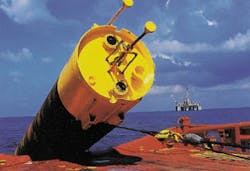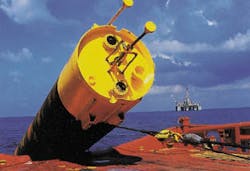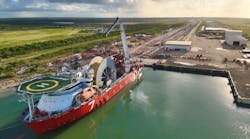William Furlow
Houston
This suction anchor is equipped with two protrusions made up of six-strand wire. Used with the Delmar Sub Sea Connector this anchor can be preinstalled using one anchor handling vessel.
One-boat installation, semi-taut mooring
Shell Deepwater Drilling Superintendent William von Eberstein worked with Delmar Systems to develop an innovative preinstalled semi-taut suction anchor mooring system to extend the depth of a moored semisubmersible. The eight-suction pile anchor system can handle greater vertical loads than the traditional cantilevered drag embedment anchor system. This means a smaller foot print. This tighter array of anchors and shorter lines translates to better stationkeeping and extended water depths. Using this system successfully to moor the semisubmersible Transocean Marianas in 5,391 ft of water in the Gulf of Mexico block Green Canyon 854, Shell is convinced a fourth or fifth generation semisubmersible can be moored successfully in more that 7,000 ft of water. The world-record mooring depth installation was accomplished using only one anchor handling vessel, the Gary Chouest. Mooring is preferred to dynamic positioning when available because of the superior stationkeeping, but other factors such as the cost of preinstalling, the variable load of carrying a deepwater mooring system, the down time of mooring and pretensioning, and the technical limits of a cantilevered system often lead an operator to choose dynamic positioning.The use of suction anchors in permanent mooring systems has been going on for some time in the North Sea and Royal Dutch Shell holds a patent on the concept, but the use in a temporary, drilling system was new. This system uses a single anchor handling vessel equipped with the Delmar Subsea Connector. This subsea mooring line connector can attach and detach from a protrusion on the suction anchor. Traditionally two boats are used for such an installation, one to lower the anchor and one to stabilize it. Not only does this installation method require a second boat, but it fails to relax the torsional rigidity in the wire. Swivels are used to allow the wire to unwind be these fail to relieve all the tension. By suspending the anchor from the protrusion, connected to the subsea connector, the Delmar method allows the anchor to spin freely. Once the anchor stops spinning, the connection to the second protrusion is made and the first connection is unmade using a remotely controlled vehicle (ROV). An ROV is also used to connect and disconnect the pre installed mooring line. Because the anchor is lowered over the stern of the anchor handling vessel on a gravity hook and lowered the first 200 ft on a one protrusion and then balanced on another it is essentially vertical at the seafloor, allowing the 80 wet-ton caisson to deadweight penetrate to about 30 ft. At this point the ROV attaches to a valve at the top of the caisson and pumps the anchor 50 ft further into the seabed. The large volume soil capture is key to the vertical lift capabilities of this system. These anchors are installed vertically and do not require pretensioning. Because the entire system, anchors, mooring line, and syntactic buoys, are preinstalled, rig time can be maximized. The Subsea Connector also allows for maintenance and replacement of mooring lines without the removal of the anchor. Because the anchor is undisturbed by these activities, conventional mooring lines can be used on permanent systems.
ABB will supply 20,000 psi wellhead in North Sea
ABB Vetco Gray will supply Elf Exploration with a 20,000 psi wellhead for reentry of a development well in the Elgin/Franklin fields of the North Sea. The well is being extended to the deeper Triassic zone. This is the first time a well offshore Western Europe has been extended to such high temperatures and pressures. The wellhead will not only be required to handle pressures up to 20,000 psi, but operating temperatures of 450°. This fast-track project will be the second 20,000 psi wellhead used in UK waters. The first was also supplied by ABB for the Central Graben area of the North Sea.Overbuild backlash
No one can fault the industry for speculative overbuilding during the recent "boomlet". Nevertheless cost overruns, delays in delivery and renegotiation of standing contracts are certain to put the pinch on drillers. While new build rigs will be coming out of the shipyards costing more than expected when their initial day rates were negotiated, the current climate is already chipping away at these numbers. Operators who can't get out of their high-dollar, long-term contracts will certainly be negotiating lower day rates. This means the drillers whose vessels are more expensive will be trying to pay them off with day rates that are less equitable. Although the new build market appears poised for a shakeout, industry insiders are predicting a bloodbath in the area of rig conversions. It was conversions where the greatest delays and overruns were experienced. Often a driller could not be sure what he would find once he began cutting open one of these older rigs, and every surprise that was not on the original plans quickly became a cost overrun.Additionally, in the contracting rig market of the near future, who wants a conversion when he can contract a new-build for the same low price? In the new market all but the most elite of the rig fleet will go wanting as the small number of operators with contracts to offer hand-pick the finest vessels available. Observers expect to see further mergers and acquisitions among drillers as companies rush to reduce costs and stablize cash flows, bracing themselves for the coming glut.
ETPA deploys first multi-phase pig launching system for BP
ETPA member Coflexip Stena Offshore (CSO) announced the deployment of this pig launching system late last year for BP. The system can be operated without interrupting production and uses the production flow to drive the pig through the pipeline. This saves in downtime particularly in fields, such as the Machar where it was installed, that require frequent pigging operations to control parafin buildup.CSO has laid and tied in a 35 km pipeline at Machar, which is one of the world's longest subsea step-outs and one of the world's longest plastic lined subsea pipelines. Typically, down time for pigging on this platform would be two-and-a-half days for the run through plus time mobilizing and demobilizing the pigs. Two pig launches ,one for the DSV Stena Orelia and the second from the CSO Marianos, were successfully received by the platform. The system was deployed using divers, but is designed for diverless installation. ETPA is an alliance including BP, CSO, Brown & Root, EMC, AMEC, KOG, Consafe, Barmac, and Heerema.
Copyright 1999 Oil & Gas Journal. All Rights Reserved.






